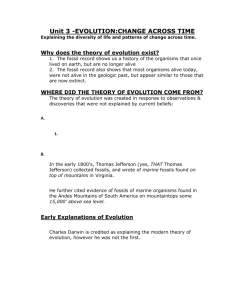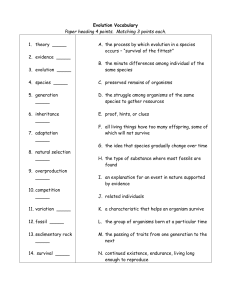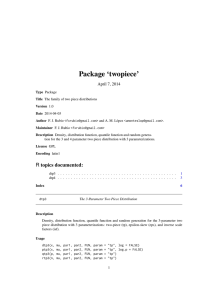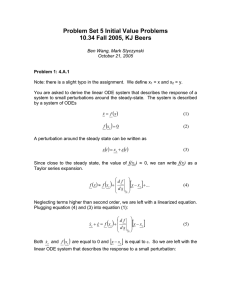REVIEW FOR EVOLUTION AND CLASSIFICATION
advertisement
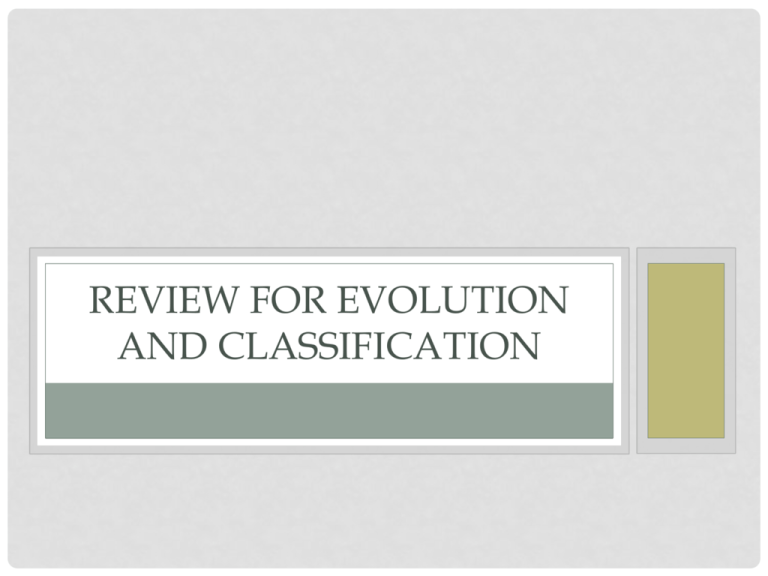
REVIEW FOR EVOLUTION AND CLASSIFICATION THE BASICS • Who is Charles Darwin? What did he do? • Father of Evolution. • Wrote Origin of Species • What does his theory explain? • How modern organisms evolved from a common ancestor NATURAL SELECTION • What is Natural Selection? • Survival of the Fittest • The organisms best suited for their environment will be the ones that survive and reproduce • What does it mean to be “fit?” • To be able to survive and reproduce NATURAL SELECTION • Under what condition does natural selection occur? • Struggle for existence – individuals produce more offspring than can survive • Variation and Adaptation • Natural inheritable variations • Adaptation – any inheritable variation that increases fitness • Survival of the Fittest • There is competition for resources and the best suited to the environment survive and pass on adaptations. PRACTICE QUESTION These feet belong to different birds. Three of the birds spend most of their time on the ground, while one bird rarely walks on the ground. Which foot belongs to the bird that is best adapted for grasping branches? PRACTICE PROBLEMS Which of the following statements describes the process of natural selection? A Farmers select animals with desirable variations for breeding. B Populations sharing the same gene pool interbreed and create new species. C Individuals survive that have inherited traits adapted to their environment. D New species are formed via genetic engineering. c PRACTICE PROBLEMS Bacteria adapt more quickly than elephants to environmental changes. Which best explains this difference? F Bacteria reproduce more rapidly. G Individual bacteria grow more steadily. H Bacterial populations are more isolated. J Individual bacteria have more genes. EVIDENCE FOR EVOLUTION • List some evidences for evolution • Biogeography – study of where animals live now and in the past • Fossils • Comparative Structures • Homologous • Analogous • Vestigial Structures • Embryology • Molecular Biology FOSSILS GIVE TWO SIMILARITIES BETWEEN EACH OF THE SKULLS THAT MIGHT LEAD TO THE CONCLUSION THAT THESE ARE ALL RELATED SPECIES. Equus (modern horse) Pilohippus Merychippus 1. Similar jaw shape 2. Eyes on the same side of the head 3. Similar shape of skull Mesohippus Eohippus (Dawn Horse) PRACTICE QUESTION Scientists found the fossilized remains of a canine’s jaw and leg. What information must first be obtained before the scientists can place the fossils in the ancestral time line of the dog? A The rest of the skeleton B The continent where the fossils were found C The age of the fossils D The population trends for the species Giant fossil ferns have been found in Canada. Which conclusion can be drawn from this discovery? F Canada once had a much warmer climate. G Giant dragonflies once lived among the ferns. H Canada was once covered by an ancient sea. J Dinosaurs once lived in Canada. COMPARATIVE ANATOMY: LET’S COMPARE AND CONTRAST HOMOLOGOUS STRUCTURES AND ANALOGOUS STRUCTURES • Homologous Structures • Similar structures • Different Uses • Shows common ancestor • Analogous Structures • Different structures • Similar Uses • Shows adaptations to environment PRACTICE QUESETION B How does comparing the skeletons of these animals provide support for the scientific theory of evolution? A. It provides information about the organisms’ habitats. B. It shows possible common ancestry between organisms. C. It provides information to determine the organisms’ ages. D. It shows possible chromosomal similarities between organisms PRACTICE QUESTION A paleontologist found this fossil. The paleontologist could say that this organism was a F mammal G vertebrate H plant J protist EMBRIOLOGY • How does embriology show evidence of evolution? • There are many similarities in the development of embryos in different species. PRACTICE PROBLEMS 1 A PRACTICE PROBLEMS B Some snake embryos have small buds resembling limbs. These buds disappear at later stages of embryo development. These findings suggest that these snakes — A had a parent with limbs B have functional limbs as adults C will have offspring with limbs D evolved from an ancestor that had limbs MOLECULAR BIOLOGY • How does molecular biology show evidence for evolution? • There are many, many similarities in the DNA of different species. PRACTICE PROBLEMS Which of the following is evidence to support the idea that two different species might have a common ancestor? F Their fossils were discovered in the same location. G Many of their genes are the same. H Their methods of respiration are alike. J They use the same means of locomotion. D WHAT CONDITIONS CAN CAUSE EVOLUTION TO OCCUR? • • • • • Sexual Selection Small Population Size Immigration or Emigration Mutations Natural Selection CLASSIFICATION • What is taxonomy? • The study of classification systems • What is binominal nomeclature? • The 2 name system we use for scientific names. • Why do we need scientific names? • Regional differences in names (an animal having more than 1 name • Some names refer to more than 1 animal. CLASSIFICATION • What is the first word in the name? • Genus • What is the 2nd word in the name? • Species • What does a dichtomous key do? • Help you identify organisms. Genus, Species Smith, James According to this key, to what family does the insect above belong? A Dytiscidae B Haliplidae C Gyrnidae D Noteridae PRACTICE QUESTION Which of these species is most closely related to Felis rufus? A Acer rubrum B Selasphorus rufus C Felis concolor D Canis rufus Which of the following would most likely change the current classification of two closely related flower species to a single species? A The discovery of a new, related species B An analysis of the DNA sequence of each species C An analysis of photosynthesis for each species D The collection of seeds from each species PRACTICE QUESTION One of the accepted scientific theories describing the origin of life on Earth is known as chemical evolution. According to this theory, which of the following events would need to occur first for life to evolve? A. onset of photosynthesis B. origin of genetic material C. synthesis of organic molecules D. formation of the plasma membrane PRACTICE PROBLEMS J F EVOLUTION AS GENETIC CHANGE IN POPULATIONS • How does natural selection affect single-gene traits? • Causes a change in the allele frequencies PRACTICE PROBLEMS C NATURAL SELECTION ON POLYGENETIC TRAITS • What is Directional Selection? What does the graph look like? • It is where natural selection favors the offspring on one side of the curve. • It moves the curve (has a dotted line) NATURAL SELECTION ON POLYGENETIC TRAITS • What is stabilizing selection? • Natural selection favors the offspring in the middle of the curve • Ex: birth size in human babies NATURAL SELECTION ON POLYGENETIC TRAITS • What is disruptive selection? • Individuals at the ends of the curve have a higher fitness than the individuals in the middle of the curve • If pressures are strong enough and last long enough, it can cause the curve to split into to different phenotypes WHICH GRAPH BEST ILLUSTRATES THE EXPECTED CHANGE IN THE FINCH POPULATION IF THE ENVIRONMENT CHANGES TO FAVOR SMALL BEAKS? HUMAN EVOLUTION • What is an anthropoid? • A group of humanlike primates • Examples include monkeys, great apes, and humans • What are hominoids? • Great Apes • Our closest ancestors HUMAN EVOLUTION PRACTICE PROBLEM Researchers concluded from the leg bones of the fossil shown in Figure 26– 2 that Lucy was bipedal. Which of the following would also indicate that this hominine was bipedal? A. broad rib cages B. opposable thumbs C. skulls with flat faces D. bowl-shaped pelvises PRACTICE PROBLEMS • Having a thumb that can move against the other fingers makes it possible for a primate to A. hold objects firmly. B. display elaborate social behaviors. C. merge visual images. D. judge the locations of tree branches Suppose a paleontologist discovered a fossil skull that he believes might be distantly related to primates. Unlike true primates, the face is not quite flat and the eyes do not face completely forward. The paleontologist would most likely conclude that the animal lacked A. the ability to form extended family groups. B. the ability to grip branches precisely. C. the ability to manipulate tools. D. the ability to judge the location of tree branches. HUMAN JAW AND SKULL VIDEO, IF TIME • <object width="560" height="315"><param name="movie" value="http://www.youtube.com/v/g0D_k4lYrdo?hl =en_US&amp;version=3"></param><param name="allowFullScreen" value="true"></param><param name="allowscriptaccess" value="always"></param><embed src="http://www.youtube.com/v/g0D_k4lYrdo?hl=e n_US&amp;version=3" type="application/xshockwave-flash" width="560" height="315" allowscriptaccess="always" allowfullscreen="true"></embed></object>

